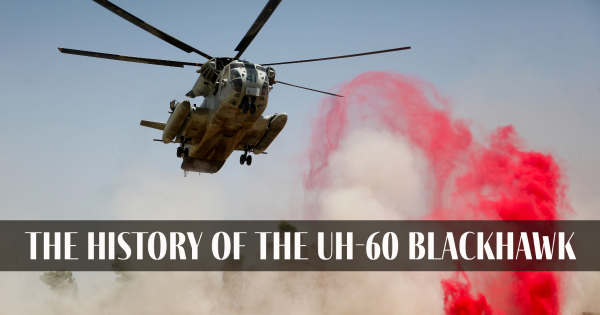Understanding the Mechanics and Design Behind Uh 60 Helicopters
The UH-60 helicopter, generally known as the Black Hawk, stands as a peak of modern rotorcraft technology, symbolizing a blend of durable engineering and detailed auto mechanics. As we peel back the layers of the UH-60's style, a world of intricate systems and meticulous design comes to light.
Background of UH-60 Helicopters
The background of UH-60 helicopters traces back to the late 1970s when the United States Army sought a sophisticated and versatile utility helicopter to replace its aging fleet. In response to this requirement, the Sikorsky Aircraft Corporation developed the UH-60 Black Hawk helicopter. Presented in 1979, the UH-60 quickly came to be a staple in army operations because of its excellent abilities.
The UH-60 was made to master a variety of objectives, including troop transportation, clinical emptying, digital war, and unique procedures. Its capability to adapt to different functions made it an important asset to the united state Army and various other army pressures around the globe
Throughout the years, the UH-60 platform has undergone a number of upgrades and variants to improve its performance and maintain rate with advancing objective needs. These helicopters have seen considerable solution in disputes such as the Gulf War, Afghanistan, and Iraq, showcasing their integrity and convenience in varied operational atmospheres. The UH-60's abundant history is a testament to its enduring heritage as a leading utility helicopter.

Engine and Power Solutions
Using sophisticated propulsion modern technology, UH-60 helicopters are equipped with innovative engine and power systems to make certain optimum performance and integrity in a series of functional circumstances. The UH-60, frequently called the Black Hawk, is powered by 2 General Electric T700-GE-701D engines, each with the ability of supplying up to 1,940 shaft horse power. These turboshaft engines provide the needed thrust for the helicopter to perform its goals effectively, including army transport, clinical emptying, and battle assistance.

Rotor System and Aerodynamics
How do the rotor system and aerodynamics of UH-60 helicopters contribute to their operational performance and visit homepage flight capacities? The rotor system of the UH-60 helicopter plays a vital duty in offering lift and propulsion.
Aerodynamics likewise play an essential role in the performance of UH-60 helicopters. The structured fuselage and blades blade layout decrease drag, permitting the helicopter to achieve higher rates and better fuel effectiveness. The aerodynamic layout of the UH-60 likewise adds to its ability to operate in diverse environmental conditions, including hot temperature levels and high altitudes.
Avionics and Flight Control Solution

In its complex coordination with the blades system and the rules of aerodynamics of UH-60 helicopters, the avionics and flight control systems develop an essential network of modern technologies forming the aircraft's functional capabilities. Avionics include the digital systems utilized for communication, navigation, and keeping an eye on numerous airplane functions. In the UH-60, these systems include digital screens, communication radios, GPS navigation, weather radar, and autopilot systems. These avionics systems provide important details to the pilots, boosting situational understanding and making certain effective and safe operation of the helicopter.
The trip control systems of the UH-60 are in charge More hints of converting the pilot's inputs into the suitable modifications to the blades system, making certain stable flight and ability to move. These systems contain hydraulic actuators, servos, and computer systems that collaborate to regulate the tail and major rotors, in addition to other flight control surfaces. By precisely managing the helicopter's flight characteristics, these systems make it possible for pilots to carry out a vast array of objectives, from transport and search-and-rescue to fight operations, with precision and confidence.
Duty and Applications in Aviation
Avionics systems in UH-60 helicopters incorporate a variety of digital systems that aid in navigating, interaction, tracking, and regulating different airplane functions. These systems consist of digital screens, autopilot systems, communication radios, General practitioner navigating devices, and weather radar. In addition, these systems incorporate safety functions such as auto-pilot settings, terrain recognition alerting systems, and security augmentation systems to enhance the total safety and security and operational capabilities of the UH-60 helicopters in numerous objectives, consisting of army transport, clinical emptying, search and rescue, and aerial firefighting.
Verdict
In final thought, the UH-60 helicopter my review here is a versatile airplane with an abundant background and advanced engineering. Its engine and power systems, rotor system, the rules of aerodynamics, avionics, and trip control systems all function with each other to make it a reputable and reliable machine.
In its complex coordination with the blades system and the rules of aerodynamics of UH-60 helicopters, the avionics and flight control systems create a vital network of technologies forming the airplane's operational abilities.The flight control systems of the UH-60 are liable for equating the pilot's inputs right into the ideal changes to the rotor system, making certain secure flight and maneuverability. Avionics systems in UH-60 helicopters encompass a variety of digital systems that help in navigation, interaction, surveillance, and controlling various aircraft functions. Furthermore, these systems incorporate safety features such as autopilot settings, surface understanding advising systems, and stability enhancement systems to enhance the general safety and functional capacities of the UH-60 helicopters in various goals, consisting of troop transport, clinical evacuation, search and rescue, and airborne firefighting.
Its engine and power systems, rotor system, aerodynamics, avionics, and trip control systems all function with each other to make it a reputable and efficient maker.